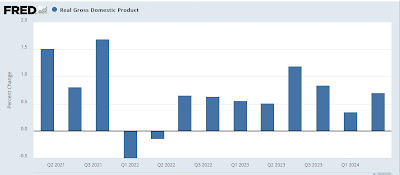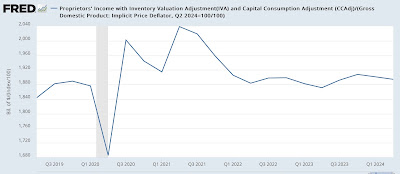Coincident real GDP metric is good, but leading indicators from the GDP report are not: is the Fed listening? – by New Deal democrat Real GDP grew 0.7% in Q2, or a 2.8% annualized rate, a perfectly good number in line with the past three years: Probably even more importantly, the GDP deflator increased 0.6% for the quarter, or at an annualized rate of 2.3%. As the below graph shows, this is a perfectly normal rate going back to the start of the Millennium: In other words, if 2% inflation is a target and not a ceiling, the Fed need not wait any further before starting to trim interest rates lower. And the long leading indicators contained within the GDP report ought to give them more reason to cut, because both declined slightly.
Topics:
NewDealdemocrat considers the following as important: Hot Topics, Lower Fed Rates, US EConomics
This could be interesting, too:
NewDealdemocrat writes JOLTS revisions from Yesterday’s Report
Joel Eissenberg writes No Invading Allies Act
Bill Haskell writes The North American Automobile Industry Waits for Trump and the Gov. to Act
Bill Haskell writes Families Struggle Paying for Child Care While Working
Coincident real GDP metric is good, but leading indicators from the GDP report are not: is the Fed listening?
– by New Deal democrat
Real GDP grew 0.7% in Q2, or a 2.8% annualized rate, a perfectly good number in line with the past three years:
Probably even more importantly, the GDP deflator increased 0.6% for the quarter, or at an annualized rate of 2.3%. As the below graph shows, this is a perfectly normal rate going back to the start of the Millennium:
In other words, if 2% inflation is a target and not a ceiling, the Fed need not wait any further before starting to trim interest rates lower.
And the long leading indicators contained within the GDP report ought to give them more reason to cut, because both declined slightly.
First, private fixed residential investment as a share of GDP, a proxy for the housing market, declined slightly both in nominal (blue) and real (red) comparisons:
This doesn’t scream recession, but the generally flat trend of the past several years (with the supply chain tailwind now gone) at very least suggests lackluster growth ahead.
Secondly, real deflated proprietor’s income, a proxy for corporate profits (which won’t be reported for another month, also declined, by -0.4%:
Business profitability is also not providing any help to the economic outlook for 2025.
Continued resilient real consumer income and spending is keeping the economy growing. But the power sources for that engine are not providing any more juice.
Again, not recessionary, but more evidence that the Fed should start to lower rates now.
Leading indicators in the Q1 GDP report are mixed, Angry Bear by New Deal democrat




